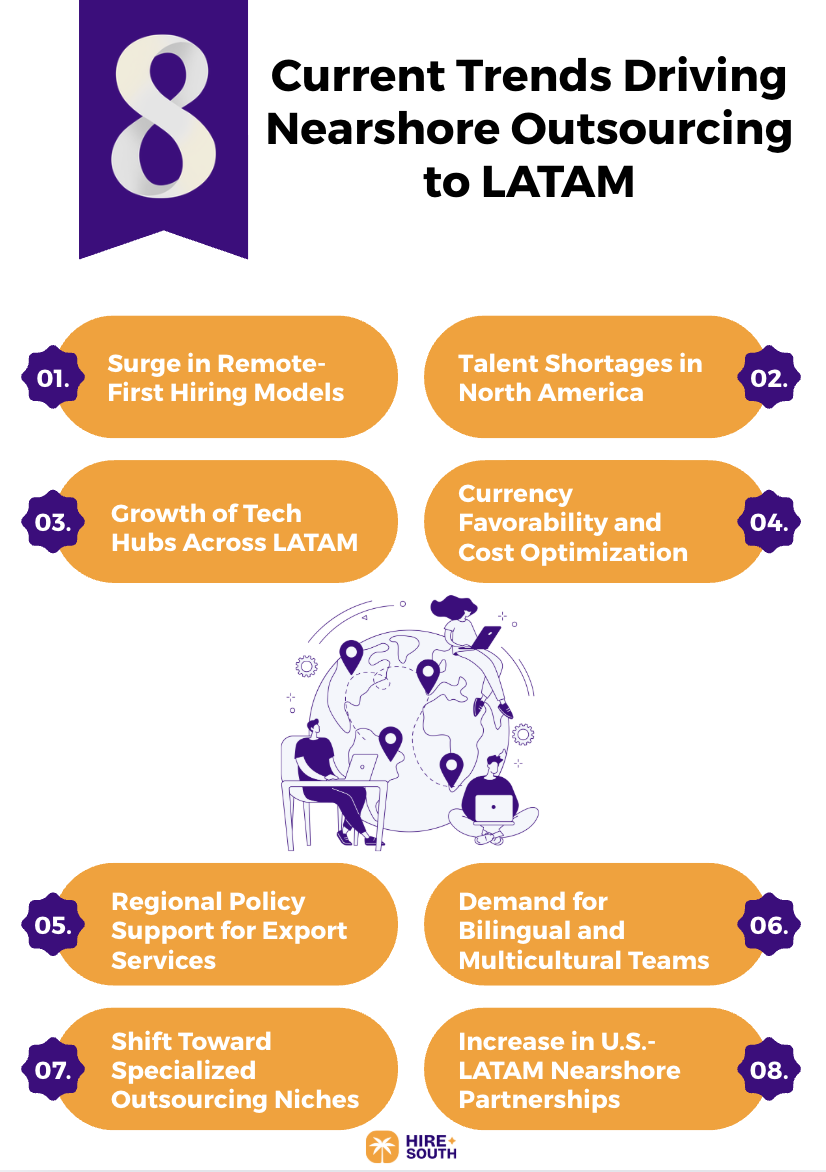Outsourcing to Latin America has become a strategic move for companies across the U.S., Canada, and Europe. With the region’s growing tech talent, cost-effective services, and real-time collaboration potential, more businesses are turning to nearshore partners to fill critical roles.
In fact, the LATAM outsourcing market is projected to grow at a CAGR of 7.8% through 2028, according to Research and Markets. From Mexico to Argentina, the region offers a unique mix of technical expertise, cultural compatibility, and geographic convenience.
This article breaks down why Latin America outsourcing has gained such traction. You'll learn about the key benefits, top countries leading the way, challenges to watch for, and how to successfully build nearshore partnerships. Whether you're hiring developers, CX agents, or digital marketers, understanding the LATAM outsourcing landscape could give your business a real competitive edge. Keep reading to learn more!
What Sets Apart LATAM from Other Outsourcing Regions?
1. Time Zone Compatibility That Enables Real-Time Collaboration:
Unlike traditional outsourcing hubs like India or the Philippines, Latin America shares overlapping work hours with North American companies. This makes a huge difference in productivity and responsiveness.
When your team in the U.S. is starting their day, developers in Mexico, Colombia, or Argentina are already online. No need to wait overnight for updates or answers. According to Accelerance, nearly 70% of U.S. companies working with LATAM partners cite time zone alignment as a key productivity booster.
2. Cultural Similarities That Reduce Miscommunication:
Cultural alignment is often overlooked, but it’s critical to smooth collaboration. LATAM professionals tend to be familiar with Western business etiquette, communication styles, and decision-making norms. This creates fewer misunderstandings and reduces the friction that can slow down cross-border projects.
In contrast, outsourcing to regions with wider cultural gaps often requires extra onboarding, more structured communication protocols, and longer ramp-up times.
3. Strong English Proficiency in Key Markets:
Several Latin American countries have made major investments in bilingual education and English-language training. For instance, Argentina ranks #1 in Latin America and #28 globally for English proficiency, according to the EF English Proficiency Index. Colombia, Chile, and Costa Rica also rank among the top in the region.
This level of fluency reduces the need for language mediation, making day-to-day operations faster and smoother compared to countries where English is less commonly spoken.
4. Agile Familiarity and Tech Stack Alignment:
Tech teams in Latin America are already used to Agile, Scrum, and DevOps workflows. This makes onboarding faster and reduces the need for extensive training or adjustment. Developers across LATAM also work with the same frameworks and tools commonly used in the U.S., from React and Node.js to AWS and Docker.
Compare that to outsourcing destinations where legacy systems or different development methodologies still dominate. You spend more time syncing processes instead of building products.
5. Shorter Travel Time and Easier Visas:
When in-person meetings matter, whether for onboarding, team building, or strategic planning, LATAM offers easier access. Most major cities are reachable from the U.S. within 3 to 8 hours by flight.
Countries like Mexico, Colombia, and Chile also have business-friendly visa agreements with the U.S., allowing easier cross-border travel than destinations in Asia or Eastern Europe. That proximity supports hybrid or distributed models where face-to-face interactions still matter.
6. Regional Stability and Government Support:
Many LATAM countries have seen growing support for the tech outsourcing industry. Governments are offering tax incentives, tech park developments, and remote work visa programs aimed at strengthening global collaboration.
Uruguay, for example, has been ranked #1 in Latin America for IT infrastructure and e-government development by the UN E-Government Survey. Compared to regions where geopolitical instability or protectionist policies may disrupt service continuity, LATAM often presents lower risk for sustained partnerships.
7. Lower Attrition Compared to High-Churn Markets:
Talent retention is a major issue in some offshore hubs. In markets like India, tech attrition rates often exceed 25%, according to NASSCOM. In contrast, nearshore LATAM teams report significantly lower turnover, often below 10%, based on data from Stack Overflow’s 2023 Developer Survey.
Lower churn means more continuity in your outsourced projects. You’re less likely to deal with constant onboarding, knowledge loss, or shifting team dynamics.
8. Education Quality With a STEM Focus:
LATAM universities are turning out large numbers of tech graduates every year. Brazil alone produces over 100,000 engineering graduates annually, according to UNESCO. Mexico, Colombia, and Chile also invest heavily in public tech education and digital skills training.
This stands in contrast to regions where talent is abundant but lacks up-to-date certifications or practical experience with modern frameworks. LATAM’s education pipeline is increasingly aligned with global digital demands.
The 8 Current Trends Driving Nearshore Outsourcing to LATAM

Surge in Remote-First Hiring Models.
Remote-first hiring is no longer a niche approach. It's reshaping how companies structure global teams. Since 2020, distributed work has become standard across the tech and service industries. As a result, nearshore outsourcing to Latin America has accelerated, with companies looking to build fully remote or hybrid teams in similar time zones.
According to Statista, over 36% of global companies plan to increase their remote outsourcing investments in 2025.
Talent Shortages in North America.
The US and Canada are facing a significant shortage of skilled tech workers. The U.S. Bureau of Labor Statistics projects over 377,500 new software developer jobs between 2022 and 2032. Demand continues to outpace supply, especially for mid-level and senior developers.
To fill these gaps, more companies are turning to Latin America’s expanding talent pool. Countries like Brazil and Colombia graduate tens of thousands of engineers annually, helping relieve pressure on overburdened local recruiting Agencies.
Growth of Tech Hubs Across LATAM.
Major cities like São Paulo, Bogotá, Guadalajara, and Buenos Aires are transforming into tech ecosystems. These hubs are supported by public-private partnerships, international investments, and the rise of startup accelerators. Guadalajara alone is home to more than 1,000 tech companies, according to ProMéxico.
This regional development means outsourcing companies can now tap into dense talent networks, reliable infrastructure, and mature vendor ecosystems, all within a 3–7 hour flight from US business centers.
Currency Favorability and Cost Optimization.
Currency fluctuations in the region, particularly in Argentina, Colombia, and Chile, have made outsourcing to LATAM financially attractive for US and European companies. As of 2024, average hourly developer rates in LATAM range from $25 to $55, depending on skill level and country, according to Accelerance’s Global Talent Report.
This makes the region a cost-effective alternative to both domestic hiring and outsourcing to higher-cost hubs like Eastern Europe. It also enables businesses to scale faster without compromising on quality or delivery.
Regional Policy Support for Export Services.
Governments across Latin America are actively encouraging nearshore outsourcing. Mexico, Costa Rica, and Uruguay have introduced tax incentives, R&D subsidies, and special economic zones for export services.
Costa Rica, for example, has attracted companies like Intel and Amazon thanks to its Free Trade Zone Regime, which offers income tax exemptions and simplified customs procedures. These national strategies reduce operational risk and make it easier to expand cross-border partnerships.
Demand for Bilingual and Multicultural Teams.
Global markets now demand culturally flexible teams that can operate across regions. LATAM professionals bring not only English proficiency but also deep familiarity with Western media, trends, and consumer behavior.
Shift Toward Specialized Outsourcing Niches.
LATAM outsourcing has evolved beyond call centers and general back office support. Today, it’s becoming known for specialization, data engineering in Colombia, AI development in Brazil, and fintech support in Mexico.
Companies are leveraging these local strengths to outsource niche functions rather than full departments. This trend allows businesses to selectively scale capabilities while maintaining control over core operations.
Increase in U.S.-LATAM Nearshore Partnerships.
Strategic partnerships between US firms and LATAM vendors are becoming more structured. These are no longer short-term contracts but long-term engagements with shared KPIs, integrated teams, and cross-border workflows.
Data from Nintex shows that nearshore vendors in LATAM now average 24-month contract durations, a significant jump from the 12–14 months common pre-2020. This reflects growing confidence in the region’s ability to deliver sustained value, not just tactical support.
Why US Companies Prefer to Hire LATAM Talent
1. Favorable Overlap With North American Business Practices:
US companies hiring in Latin America benefit from a shared approach to business conduct. Decision-making styles, meeting etiquette, and team dynamics in LATAM markets often mirror those in the US, which speeds up onboarding and improves long-term collaboration.
There’s less need to adapt communication styles or retrain teams to match expectations. This level of cultural compatibility helps reduce friction and builds trust faster, especially on cross-functional or client-facing teams.
2. Resilience and Adaptability in Complex Projects:
LATAM professionals are known for being adaptable in fast-paced, evolving environments. Many have experience working with startups, high-growth tech firms, or multinational corporations. That makes them well-equipped to handle ambiguity and shifting project scopes.
This adaptability has real value. In a 2023 Harvard Business Review study, teams in Latin America ranked high in "resilience under uncertainty" compared to global averages, especially in software and creative roles.
3. Improved Retention Rates Compared to Domestic Hires:
Retention is one of the biggest hidden costs in hiring. US companies often face high churn rates for technical roles, especially in competitive metro areas. Hiring from Latin America can help stabilize teams.
Data from Terminal’s 2023 LATAM Hiring Report shows that developer retention rates in the region are 15% to 30% higher than equivalent roles in the US. Professionals in LATAM tend to prioritize job stability and long-term growth over frequent job hopping, particularly in mid-senior roles.
4. More Control Than Traditional Offshore Models:
Because of its time zone alignment and cultural similarities, LATAM gives U.S. companies more direct involvement in project management compared to far-shore models. This leads to tighter feedback loops, fewer handoff delays, and more accountability from all sides.
You’re able to run daily standups, real-time code reviews, and live design sprints, without late-night calls or asynchronous bottlenecks. This hands-on access can significantly improve quality and speed in agile workflows.
5. Strong University Pipeline Feeding Into Global Teams:
Top universities across LATAM are producing engineering, design, finance, and analytics talent that meets international standards. Schools such as ITESM (Mexico), Universidad de Buenos Aires (Argentina), and Universidade de São Paulo (Brazil) are globally ranked for their STEM disciplines.
U.S. companies hiring LATAM professionals often find candidates with deep academic training and real-world experience through co-ops, bootcamps, or startup exposure. This establishes a solid foundation for building technical teams that scale effectively.
Ready to Get Started with Latin America Outsourcing?
We hope this article offered you greater insights into how Latin America has moved from being a cost-saving option to a strategic advantage for companies building agile, scalable, and resilient teams. With high retention, strong technical education, and real-time collaboration potential, it’s no surprise that LATAM outsourcing continues to grow by over 7% annually, according to Research and Markets.
At Hire South, we specialize in helping businesses tap into top-tier LATAM talent without the complexity of other outsourcing models. Our team combines regional expertise, rigorous vetting, and local market knowledge to ensure you get professionals who align with your goals, on time, within budget, and fully integrated. Whether you're scaling engineering teams or building remote operations, we’re here to help you do it right. Contact us to schedule a FREE consultation!

Ready to Hire LATAM Talent?
Let us do the legwork to find your perfect remote hire in Latin America!



.jpg)
.jpg)


.svg)